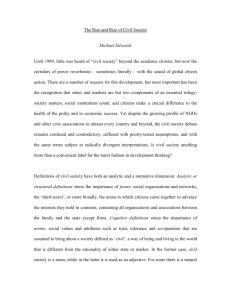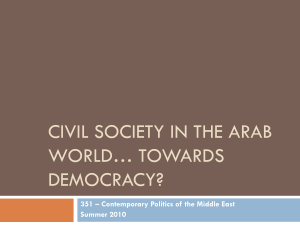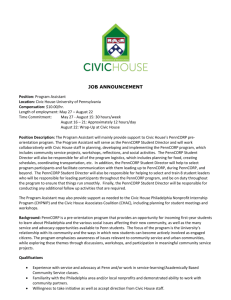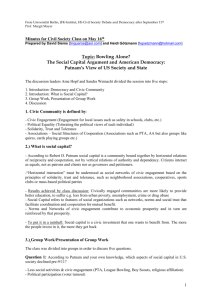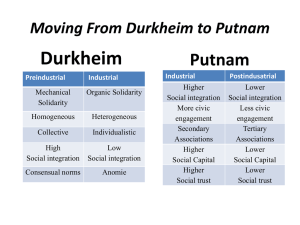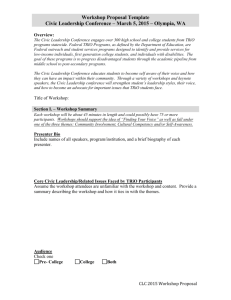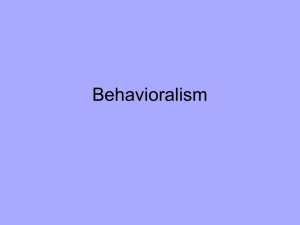Social Capital as Participation
advertisement
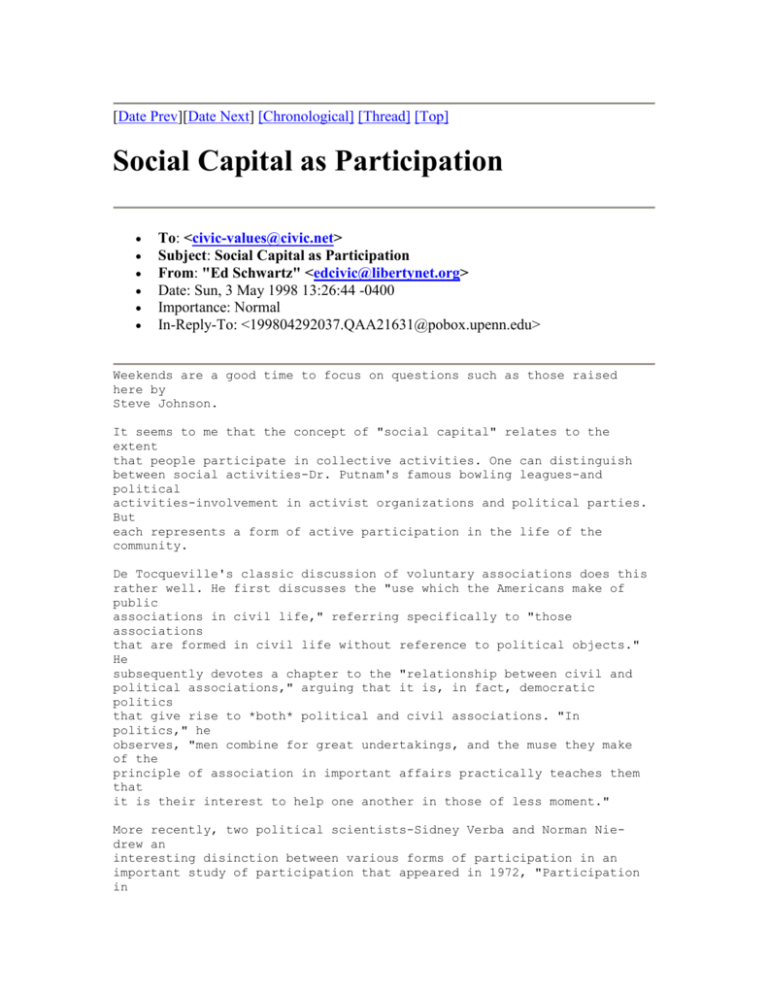
[Date Prev][Date Next] [Chronological] [Thread] [Top] Social Capital as Participation To: <civic-values@civic.net> Subject: Social Capital as Participation From: "Ed Schwartz" <edcivic@libertynet.org> Date: Sun, 3 May 1998 13:26:44 -0400 Importance: Normal In-Reply-To: <199804292037.QAA21631@pobox.upenn.edu> Weekends are a good time to focus on questions such as those raised here by Steve Johnson. It seems to me that the concept of "social capital" relates to the extent that people participate in collective activities. One can distinguish between social activities-Dr. Putnam's famous bowling leagues-and political activities-involvement in activist organizations and political parties. But each represents a form of active participation in the life of the community. De Tocqueville's classic discussion of voluntary associations does this rather well. He first discusses the "use which the Americans make of public associations in civil life," referring specifically to "those associations that are formed in civil life without reference to political objects." He subsequently devotes a chapter to the "relationship between civil and political associations," arguing that it is, in fact, democratic politics that give rise to *both* political and civil associations. "In politics," he observes, "men combine for great undertakings, and the muse they make of the principle of association in important affairs practically teaches them that it is their interest to help one another in those of less moment." More recently, two political scientists-Sidney Verba and Norman Niedrew an interesting disinction between various forms of participation in an important study of participation that appeared in 1972, "Participation in America: Political Democracy and Social Equality," published by Harper & Row. . Their categories, as defined between pp. 100-102, were as follows: Inactives-45% of this group were people without high school diplomaswho constituted only 28% of the country. Voting Specialists-People who voted and did nothing else. Parochial Participants-These are people who get involved to solve a particular problem. Once it's solved, they withdraw. Communalists-These are people who participate primarily in community and civic associations, but do not get involved in political parties. At the time of the study, this group was represented heavily in the suburbs and rural areas, but not cities. Partisan Activists-These are people who participate primarily in political parties and elections, but do not get involved in civic and community organizations. At the time of the study, this group was represented heavily cities where party organization still existed. Complete Activists-These are people who get involved in just about everything. At the time, they came mostly from the upper-middle class. "The degree of overrepresentation of those at the top of the status hierarchy is striking," the authors observe. The basic conclusions of this study were-surprise, surprise-that high status groups were overrpresented, and low status groups were underrepresented as participants in the community and politics. But the categories themselves were quite useful then, and remain useful now, I think The indices that I would eliminate from Steve Johnson's list are those relating to the *satisfaction* that people may or may not feel with government. I'm not sure how much social capital is generated by a person sitting in his or her own home delighted that the sanitation department picks up the trash on time. In fact, various political scientists over the years have tried to attribute low voter turnout on broad satisfaction with the system---failing to explain why the lowest participation rates occur among groups with least reason to be satisfied. But this perverse use of satisfaction highlights its limits as a measure of social capital. The primary indicators, again, relate to participation, and as Steve Johnson's list suggests, there are a number of these available. Ed Schwartz -----Original Message----From: civic-values-approval@civic.net [mailto:civic-values-approval@civic.net] On Behalf Of Ed Schwartz Sent: Wednesday, April 29, 1998 3:37 PM To: civic-values@civic.net Subject: Research on Social Capital (fwd) >Date: Wed, 29 Apr 1998 10:00:45 -0800 >To: civic-values@civic.net >From: steverj@teleport.com (Steve Johnson) >Subject: Measuring Social Capital > >Hello, > >Writing from Portland State University, Portland, Oregon, USA, Steve >Johnson, member of social capital research team: > > >I am conducting research on methods for measuring social capital. There >must be others who have or are doing the same. The unit of analysis scope >here is to figure out how a municipality/urban area can measure its present >stock of social capital, and then how to measures upturns and downturns as >it implements programs over time. As with Putnam's work, our focus here is >on measuring social capital in the context of civic capacity. > >I have so far broken down the methods for measuring social capital into >several, distinct, but obviously overlapping, types. > > >1. Bowling Alone model > >Using Putnam's way of measuring national trends in social capital, >connectedness and trust, relying mostly on General Social Survey questions. >As a footnote here a PSU institute just recently published a short atlas >of maps measuring social capital, using some of Putnam's criteria (see >below for list of the factors that were mapped) > > >2. Citizen Participation: Relation of Government to Citizens > >The premise here is similar to Rebirth of Urban Democracy. Using >measurements of levels of citizen participation, and two way channels of >communication between citizens and government, and ability of citizens to >effect government policy. Trust also might be measured, alone lines of >Putnam's method. > >The investment government makes in citizen-government relations would also >be important to measure. For example, in the Portland area the invesment >is in the range of $15-$20 million annually, based on budgets for >participation, outreach, etc. > > >3. Government Performance/Citizen Satisfaction > >With obvious similarities to #2, here the model would be variations on city >auditor reports, and citizen-led monitoring and assessments of government >performance, and satisfaction citizens feel about life in the community, at >least as far as it is affected by government programs. > > >4. Community Asset Mapping > >The Kretzman/Mcknight model of building upon community assets. Here the >focus would be on inventorying what people think works in their community, >the strengths rather than deficits. This might not be a comparable >assessment process, but might be used to map changes over time in terms of >what citizens feel works are or assets in their community. > > >5. Program Intervention Evaluation > >Mostly these tools are used to asses individual, or sets of programs, but >the methods might be applicable to broader municipal social capital >assessments. > > >6. Civic Indexes > Generalized assessments of the health of communities such as the >National Civic League conducts. I have not point-by-point examined these >municipality competitions to compare and contrast measurable qualities, but >would assume the criteria overlaps with several of the aforementioned >methods. > > >Portland area civic capacity mapping: > >IMS Civic/social capital map > >Map 1: bowling centers, coffee shops, pubs, bars, barber shops, beauty >parlors, grocery and convenience stores, restaurants, tea houses > >Map 2: churches and other houses of worship > >Map 3: total number of civic places > >Map 4: dimensions of social capital, associations, houses of worship, >third places, small industries > >Map 5: small manufacturing establishments > >Map 6: total associations, clubs, organizations > >Map 7: index of social capital > > >So, what does anyone think of this general breakdown? Others working on >this issue? > Prev by Date: civic-values-digest V1 #1374 Next by Date: Fwd: Adult Literacy Action: Calls needed to Senators Index(es): o Chronological o Thread


